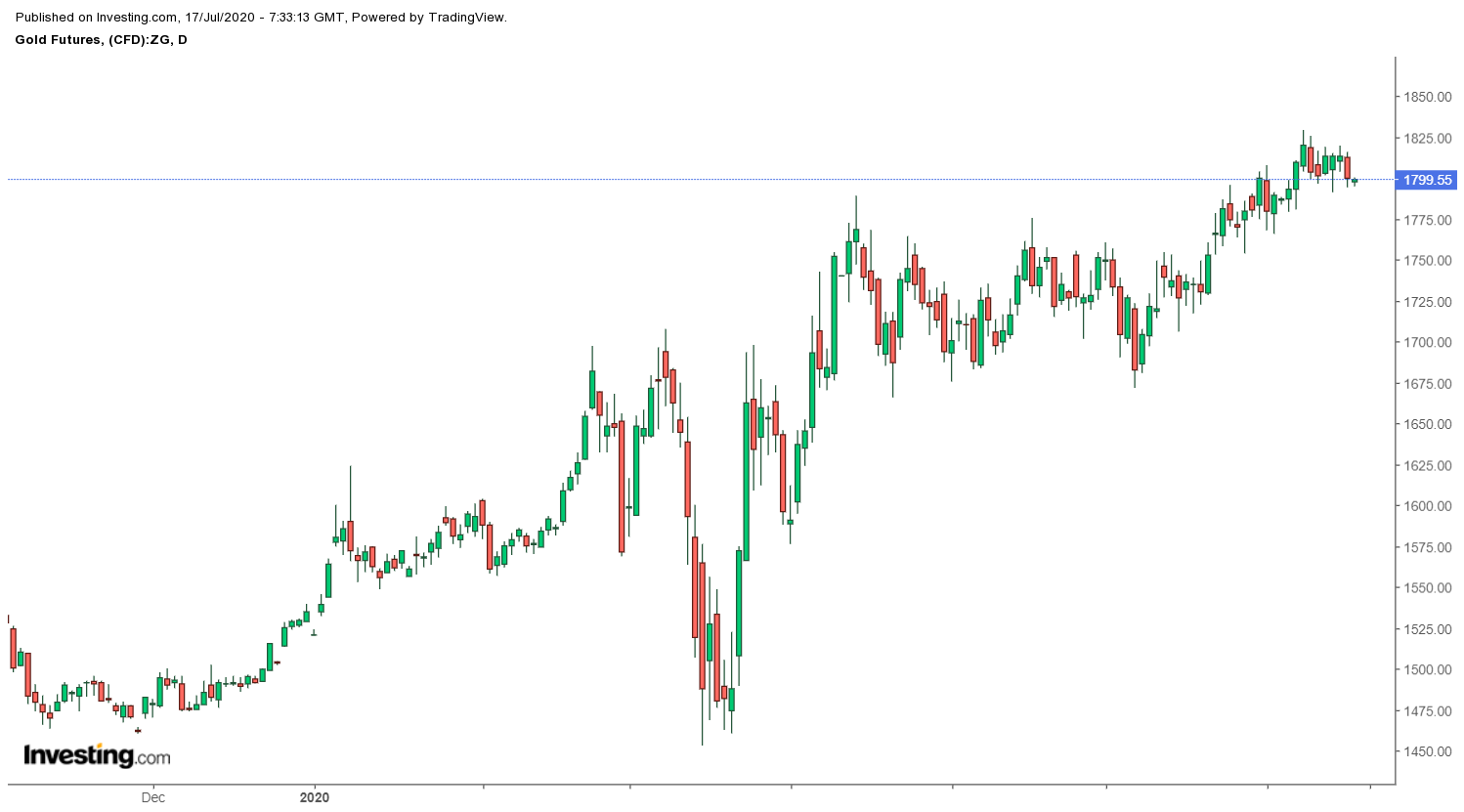Has gold transformed into a risk asset from the “safe-haven” we’ve known it to be?
Some are asking that, as the price fell its most in a week on Thursday, sliding below the key $1,800 per ounce support, despite record high numbers of cases of coronavirus in California.

Typically, when Wall Street is having a lousy day, gold should be shining. But the risk-on, risk-off play isn’t as simplistic these days, as the dollar can act as safe-haven, competing with gold for cash from worried investors—particularly when US-China tensions come to the fore. In Thursday’s session, the dollar bounced, recovering from one-month lows hit the day earlier.
Gold Taking Time With Advance Beyond $1,800
While the Federal Reserve is on standby to prevent another cash crunch like that seen in the early days of the pandemic, some worry there could still be a run on gold if stocks crash again—thus preventing it from making major strides above $1,800. In fact, at the time of writing, gold hovered just below that level.
“Gold is trading as a risk asset, in a regime defined by a surge in liquidity and money supply,” TD Securities said in a note on Thursday as COMEX gold futures fell nearly 1%, its most in a week, despite the Dow Jones snapping a four-day winning streak.
Unless gold recovers some of those declines on Friday, the price is likely to see its first weekly loss in six by the close close.
Look Out For Gold-Positive Shocks
The risk-on environment has, meanwhile, had a limited impact on bullish investor bets on gold, given the macroeconomic backdrop, TD Securities said. “We expect that these common drivers will continue to drive capital to shelter itself from negative real yields in risk and real assets."
“Therefore, we argue that money managers need not be concerned about trading gold in a risk-on environment, but instead should continue to watch for adverse shocks to the prevailing themes that have driven gold positioning higher."
Analysts said gold prices might have dropped more on Thursday had it not been for safe-haven bids from buyers worried about the continued escalation in cases of COVID-19 in the United States.
The United States reported more than 67,000 new cases of coronavirus on Wednesday. Top US infectious diseases expert Dr. Anthony Fauci said recently daily growth in cases could reach 100,000, without proper social-distancing and other safety measures.
Virus Keeps Gold Supported
More than 3.5 million Americans have been infected by COVID-19, with a death toll surpassing 140,000. A new model by the University of Washington predicts 200,000 coronavirus deaths in the United States by Oct. 1, casting further doubts on economic reopening from lockdowns.
“Gold prices remain trapped in a range as virus uncertainty is countered by vaccine progress and as central banks adopt a wait-and-see approach for the rest of the summer,” said Ed Moya, analyst at OANDA.
Moya, however, said fiscal response by the Fed and other global central banks to the pandemic was not expected to slow, and that should hold gold above $1,800 and help it crack the $1,900 record highs set in 2011.
He added:
“Gold’s best friend has been stimulus, and there will be no shortage of that anytime soon."
The US economy shrank 5% in the first three months of 2020, its sharpest decline since the Great Recession of 2008/09, as most of the 50 states in the country went into lockdown to stem the spread of the virus. While most businesses have reopened over the past two months, economists still warn of a double-digit recession by the second quarter. The Fed is determined to soften the landing.
“The gold price rally has cooled off in recent days, but that doesn’t mean that the technical structure has turned less bullish,” Christopher Vecchio, an independent analyst who contributes to Daily FX, said. “The fundamental argument—that real yields will remain low, if not in negative territory—remains robust as well.”
It’ll Be The Fed’s Work, At The End Of The Day
Vecchio noted that neither gold, nor silver, did well in 2008 or 2009, instead, the bulk of their gains—and the truly impressive stretch of their performance—came in 2010 and 2011 when the Fed was providing ample monetary support to markets.
He said:
“Putting this all together, it’s important to think about The Great Lockdown (one of the colloquialisms used to describe the current economic malaise) to The Great Recession.
With the Federal Reserve keeping its main rate tethered near zero through 2022, these factors will only enhance the negative real yield argument that has been fueling gold and silver’s rallies in recent months."
Moya agreed with that thesis:
“Gold is likely to continue to see record ETF inflows as coronavirus worries continue to worsen."
Gold should continue to rise as US business activity lost most of its reopening momentum and many investors anticipate more stimulus will be thrown to try to avoid permanent labor damage to the economy.”
Disclaimer: Barani Krishnan does not own or hold a position in the commodities or securities he writes about.
